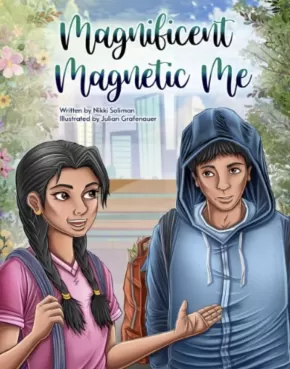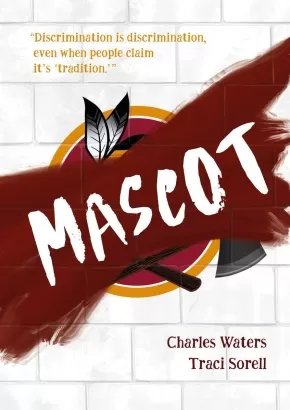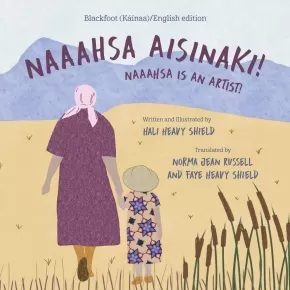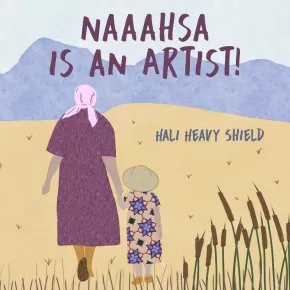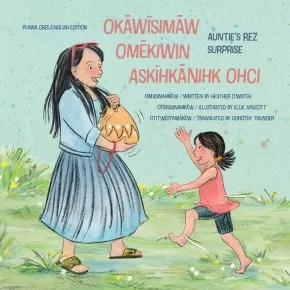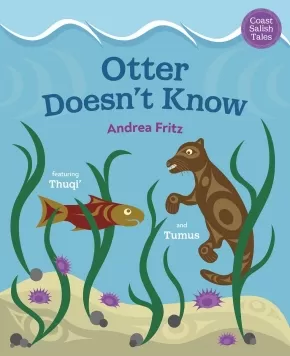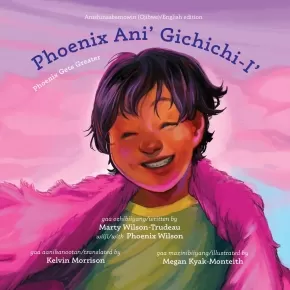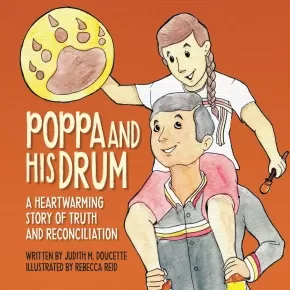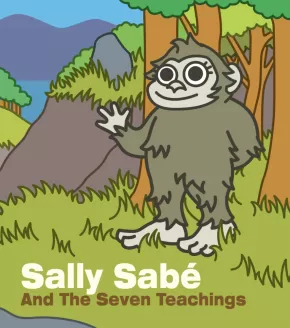
Healing and Wellness
211
-
225
of
631 Results;
Sort By
Go To
of 43
Maggie Lou Meets Her Match
$14.99
Format:
Paperback
Text Content Territories:
Indigenous Canadian; Métis;
ISBN / Barcode: 9781773067742
Synopsis:
Synopsis:
In this sequel to Maggie Lou, Firefox, the irrepressible Maggie Lou acquires a new cousin, and a horse - both of whom have minds of their own.
When Uncle Bobby gets married, Maggie Lou suddenly finds herself with a new cousin, Rosie. Rosie is the same age as Maggie. She also has a fabulous head of curls, although hers are red. And Rosie knows everything about horses and riding - something Maggie Lou has longed to do.
A rivalry sparks between the girls from the start at Uncle Bobby and Aunt Bonnie's wedding, which features an all-you-can-eat dessert table, as well as lots of energetic dancing. On Rosie's horse farm, Maggie experiences her share of humiliations as she learns how to ride on a pony so short that her feet can touch the ground.
Eventually the cousins become allies and wreak some hair-raising mischief, including a secret midnight horseback ride. And in the end they are joined by friends and family to train, hilariously, for the famous Otipîm'sowak Race - a Métis voyageur relay - carrying on a family tradition.
Throughout it all, Maggie remains stubborn and enthusiastic, as she navigates the new challenges of defeat, rivalry and family change.
Reviews
"A high-energy love letter to rambunctious girls, big families, and Métis culture." — Kirkus Reviews, June 2025
"Full of hilarious high jinks yet bursting with heart ... This book shines with realistic sibling relationships, funny dialogue, strong intergenerational bonds, and a steadfast connection to community and culture."— Booklist, July 2025
Educator & Series Information
Recommended for ages 9 to 12.
This book is the second book in the Maggie Lou series.
Key Text Features: chapters; character drawings; dialogue; glossary; illustrations.
Additional Information
228 pages | 5.00" x 7.50" | b&w illustrations | Paperback
Magnificent Magnetic Me
$19.99
Artists:
Format:
Paperback
Text Content Territories:
Indigenous Canadian;
ISBN / Barcode: 9781990297434
Synopsis:
Synopsis:
Métis writer and educator Nikki Soliman walks children through the importance of mental health and wellness in Magnificent Magnetic Me. This book examines the importance of embracing the tools needed to stay positive. It teaches about the power of thoughts and words and the energy we attract.
Educator Information
Recommended for grades 5 to 8.
Additional Information
32 Pages | Paperback
Mascot
$21.99
Format:
Hardcover
Text Content Territories:
Indigenous American; Native American; Cherokee;
ISBN / Barcode: 9781623543808
Synopsis:
Synopsis:
What if a school's mascot is seen as racist, but not by everyone? In this compelling middle-grade novel in verse, two best-selling BIPOC authors tackle this hot-button issue.
Six kids. One mascot. Who wins?
In Rye, Virginia, just outside Washington, DC, people work hard, kids go to school, and football is big on Friday nights. An eighth-grade English teacher creates an assignment for her class to debate whether Rye’s mascot should stay or change. Now six middle schoolers–-all with different backgrounds and beliefs–-get involved in the contentious issue that already has the suburb turned upside down with everyone choosing sides and arguments getting ugly.
Told from several perspectives, readers see how each student comes to new understandings about identity, tradition, and what it means to stand up for real change.
Reviews
"Waters and Sorell (Cherokee Nation) join forces to write about the power of being true to oneself.
In a middle school in Rye, a fictional town near Washington, D.C., a racist mural and offensive pep rally chants shock new student Callie Crossland, who is a citizen of the Cherokee Nation and African American. Callie shares a heartfelt poem with her seventh grade honors English class, reminding everyone that the “stupid tomahawk-chop chant” and the “cheap chicken-feather headdress” are nothing less than symbols of “white supremacy.” Afterward, Ms. Williams, her teacher, assigns a persuasive writing and oration project entitled “Pros and Cons of Indigenous Peoples as Mascots.” The small, broadly diverse group of students is assigned to work in pairs; Callie is matched with Franklin, who is Black and a proud fan of the Rye Braves football team. Franklin insists, “I wish we could Lysol racism away. / It’s a bad odor,” but he feels conflicted: “I still don’t think our mascot is racist though. It brings so much joy. / …what’s the big deal?” This clever novel unfolds in poems told in multiple voices showing the wide range of students’, families’, and community responses to the controversy; for some, initial feelings of opposition, hesitation, or indifference change and friendships are tested. The compelling, highly relevant subject matter and accessible text invite readers to understand different perspectives and witness individual growth.
A brilliant story not to be missed; deeply engaging from the first page. (glossary, additional information and resources) (Verse fiction. 10-14)" —Kirkus Reviews, starred review
"Told via seven alternating narratives, this ripped-from-the-headlines collaboration in verse by Waters (African Town) and Cherokee Nation member Sorrel (One Land, Many Nations) follows a fictional town’s division over a racist sports mascot. Callie Crossland, who is Cherokee and Black, has just transferred to a middle school in Rye, Va. She immediately expresses disgust at her school’s mascot, a “copper-toned, muscled, loincloth-clad, tomahawk-wielding” caricature of an Indigenous person. Callie’s English teacher Ms. Williams soon assigns a group writing project regarding the “Pros and Cons of Indigenous Peoples as Mascots,” and Callie is annoyed at being paired with Black classmate Franklin, who believes the mascot “brings so much joy.” Waters and Sorrel paint a complex portrait of the differing reactions toward the controversy by layering the racially diverse tweens’ perspectives and showcasing the effects the event has on their individual relationships and the community beyond their school. The creators eschew judgment to present a well-rounded discussion about classism and racism, as well as effective allyship, with compassion and understanding. A glossary and resources conclude. Ages 10–up." —Publishers Weekly, starred review
"Ms. Williams tasks her... honors English students with a persuasive writing and oral presentation assignment arguing the pros and cons of using Indige-nous peoples as mascots. Throughout the course of a school year the story unfolds in a series of poems that detail the per-spectives of six students: Callie (Cherokee African), Franklin (African American), Priya (Indian American), Luis (Salvadoran American), Tessa (white and previously homeschooled), and Sean (working-class white). Predictably, Callie, Priya, and Tessa (who sees herself as a committed antiracist) oppose Indigenous mascots, while the boys, who enjoy war paint and tomahawk chops at Rye Braves games, claim the mascot de-picts pride in the team and their school. While the discord around the mascot is a long-standing one in the Virginia community, the assignment empowers the students to take the issue to the school board. After further research, one student switches sides, losing a friend in the process. While the plot requires a fair amount of exposition detailing history and arguments on both sides, the characters are well developed and believable, and the story flows smoothly. A valuable classroom pick that demonstrates the importance of debate." —Booklist
Educator Information
Recommended for ages 10+
Includes a glossary and additional resources / information.
Subjects / Themes: Discrimination, Different Perspectives, Identity, Tradition, Standing up for Change, Social Responsibility, Verse Fiction / Poetry
Additional Information
256 pages | 5.75" x 8.56" | Hardcover
My Powerful Hair
$23.99
Artists:
Format:
Hardcover
Text Content Territories:
Indigenous American; Native American; Anishinaabeg; Ojibwe (Chippewa); Turtle Mountain Anishinaabe; Métis;
ISBN / Barcode: 9781419759437
Synopsis:
Synopsis:
From the award-winning and bestselling author of We Are Water Protectors comes an empowering picture book about family history, self-expression, and reclaiming your identity
Our ancestors say our hair is our memories,
our source of strength and power,
a celebration of our lives.
Mom never had long hair—she was told it was too wild. Grandma couldn’t have long hair—hers was taken from her. But one young girl can’t wait to grow her hair long: for herself, for her family, for her connection to her culture and the Earth, and to honor the strength and resilience of those who came before her.
From Carole Lindstrom, author of the New York Times bestseller and Caldecott Medal winner We Are Water Protectors, and debut illustrator Steph Littlebird comes an empowering and healing celebration of hair and its significance across Indigenous cultures.
Educator Information
Recommended for ages 4 to 8.
Additional Information
48 pages | 9.00" x 11.00" | Hardcover
Naaahsa Aisinaki! / Naaahsa is an Artist!
$21.95
Format:
Hardcover
Text Content Territories:
Indigenous Canadian; First Nations; Blackfoot Confederacy (Siksikaitsitapi); Kainai (Blood);
ISBN / Barcode: 9781772603477
Synopsis:
Synopsis:
Naaahsa says art is a language everyone understands. Sometimes we make art together. We draw, we bead, we sing. Sometimes Naaahsa tells stories in Blackfoot. I even get to go with her to see her art show at the National Gallery. Naaahsa is famous for her art, but I love her hugs best!
Naaahsa is an Artist! is a celebration of art, artists, and Indigenous women artists in particular. Each page comes to life with bold patterns, shapes, and Naaahsa's encouraging words that may inspire young readers to want to make art themselves.
Educator Information
Recommended for ages 6 to 8.
Dual-language edition in English and Blackfoot: Kainai Nation
Blackfoot translation by Norma Jean Russell and Faye Heavy Shield.
This book is available in English: Naaahsa is an Artist!
Additional Information
24 pages | 8.50" x 8.50" | Hardcover
Naaahsa Is an Artist!
$21.95
Format:
Hardcover
Text Content Territories:
Indigenous Canadian; First Nations; Blackfoot Confederacy (Siksikaitsitapi); Kainai (Blood);
ISBN / Barcode: 9781772603460
Synopsis:
Synopsis:
Naaahsa says art is a language everyone understands. Sometimes we make art together. We draw, we bead, we sing. Sometimes Naaahsa tells stories in Blackfoot. I even get to go with her to see her art show at the National Gallery. Naaahsa is famous for her art, but I love her hugs best!
Naaahsa is an Artist! is a celebration of art, artists, and Indigenous women artists in particular. Each page comes to life with bold patterns, shapes, and Naaahsa's encouraging words that may inspire young readers to want to make art themselves.
Reviews
“What a marvelous and sparkling read. How blessed are we to have Naaahsa’s wisdom for how inspiration is everywhere and, if you welcome and embrace it, the magic of the world is yours to celebrate your way in any way you wish. Thank you, Hali Heavy Shield, for sharing Naaahsa’s warmth and love. Every page feels like a hug from home.” — Richard Van Camp, author of Little You and We Sang You Home
“This book is sure to be a hit. As seen through the eyes of a grandchild, Naaahsa is an Artist! conveys the healing power of art and the importance of taking up space in institutions that have not welcomed Indigenous Peoples in the past.” — Nancy Cooper, First Nations Consultant for the Southern Ontario Library Services and coordinator for First Nation
“I love the grandmother/granddaughter relationship here and I love how proud the little girl is of her grandma. It’s a book I can relate to as I had a close relationship with my grandmother.” — Jodie Callaghan, author of Ga’s/The Train
Educator Information
Recommended for ages 6 to 8.
This book is available in a dual-language format: Naaahsa Aisinaki! / Naaahsa is an Artist!
Additional Information
24 pages | 8.50" x 8.50" | Hardcover
okāwīsimāw omēkiwin askīhkānihk ohci / Auntie's Rez Surprise
$21.95
Artists:
Format:
Hardcover
Text Content Territories:
Indigenous Canadian; First Nations; Cree (Nehiyawak); Plains Cree;
ISBN / Barcode: 9781772603453
Synopsis:
Synopsis:
Auntie always greets Cree in Nehiyaw when she comes for a visit. When Auntie arrives with a surprise gift hidden in her bag, Cree can’t wait to discover what it is. The first clue? It’s from the rez. As Cree tries to figure out what it might be, the bag starts to move!
Reviews
"Everyone has an auntie like the auntie in this book! She is eclectic and kooky and brings surprises that come with important teachings about responsibility and reciprocity.” — Nancy Cooper, First Nations Consultant for the Southern Ontario Library Services and coordinator for First Nation
“The Auntie in this story sounds so cool and I can just imagine how exciting it would be when she came to visit. This story is fun and sweet and has a great message about taking care of our pets and one another.” — Jodie Callaghan, author of Ga’s/The Train
Educator Information
Recommended for ages 6 to 8.
Dual-language edition in English and Plains Cree, Y Dialect. Translated by Dorothy Thunder.
Dorothy Thunder is a Plains Cree (nêhiyawiskwêw) from Little Pine First Nation, Saskatchewan and full-time Cree instructor in Faculty of Native Studies at the University of Alberta.
This book is available in English: Auntie's Rez Surprise.
Additional Information
24 pages | 8.50" x 8.50" | Hardcover
Otter Doesn't Know
$21.95
Artists:
Format:
Hardcover
Text Content Territories:
Indigenous Canadian; First Nations; Salish; Coast Salish; Lyackson ;
ISBN / Barcode: 9781459836211
Synopsis:
Synopsis:
You don't need to have all the answers to be a helper.
Indigenous artist and storyteller Andrea Fritz tells a tale of a salmon and a sea otter who learn it's ok to say "I don't know" and to ask for help.
Thuqi’ the sockeye salmon knows it’s time to spawn, but she is lost in the Salish Sea and doesn't know the way to Sta'lo’, the river. When she asks Tumus the sea otter for help, he doesn’t exactly know either, and he dismisses her questions. But when Tumus becomes lost in some weeds, Thuqi’ shows him that it’s okay not to know something—you can still find a way to help a friend in need.
In this original story set in Coast Salish Traditional Territory, author and artist Andrea Fritz uses Indigenous storytelling techniques and art to share the culture and language of the Hul’q’umi’num’-speaking Peoples.
Educator & Series Information
Recommended for ages 6 to 8.
This book is part of the Coast Salish Tales series.
Themes/Subjects: Nature and Animals; Fish and Marine Life; Courage, Bravery, Hope
Additional Information
32 pages | 8.75" x 10.75" | Hardcover
Phoenix ani’ Gichichi-i’/Phoenix Gets Greater
$21.95
Artists:
Format:
Hardcover
Text Content Territories:
Indigenous Canadian; First Nations; Anishinaabeg;
ISBN / Barcode: 9781772603248
Synopsis:
Synopsis:
Phoenix loves to play with dolls and marvel at pretty fabrics. Most of all, he loves to dance—ballet, Pow Wow dancing, or just swirling and twirling around his house. Sometimes Phoenix gets picked on and he struggles with feeling different, but his mom and brother are proud of him. With their help, Phoenix learns about Two Spirit/Niizh Manidoowag people in Anishinaabe culture and just how special he is.
Based on the childhood experiences of her son, Phoenix, Marty Wilson-Trudeau demonstrates the difference that a loving and supportive family can make.
Educator Information
Recommended for ages 6 to 8.
Dual-language format: Ojibwe and English.
Translated by Kelvin Morrison (Kiitaabines), who is from Nigigoonsiminikaaning First Nation in Northwestern Ontario, Wazhashk (muskrat) clan. He works as an Anishinaabemowin translator at Seven Generations Education Institute, translating books, videos, and short stories, as well as Elders’ stories and resource materials for daycares, schools, and communities. He enjoys creating tools so all can learn, understand, and hear how Anishinaabemowin sounds. He also works in the Knowledge Keepers Program offered by the Fort Frances Rainy River School Board, sharing stories, cultural knowledge, residential school experience, and teachings about the Land.
Find the English version of this book here: Phoenix Gets Greater.
This book is available in French: Phoenix le merveilleux
Additional Information
24 pages | 8.50" x 8.50" | Hardcover
Poppa and His Drum
$16.95
Artists:
Format:
Paperback
Text Content Territories:
Indigenous Canadian; First Nations; Mi'kmaq;
ISBN / Barcode: 9781774571262
Synopsis:
Synopsis:
After moving from an all-French Indigenous community to the English community of St. George's when he was a little boy, Poppa's life as a young man was very sad. He was treated badly by his schoolteachers and some other children in the town.
Years later, when his grandson wants to bring him into school to play his drum for the class, Poppa is nervous but goes anyway. He is relieved to see he is welcomed and even encouraged to share his knowledge of the traditions and customs of his Mi'kmaw culture.
Thankfully, times have changed from Poppa's generation, and he is pleased to have reconciled with the bad experiences he had when he went to school. Indeed, there is strength and wisdom in Reconciliation!
Educator & Series Information
Recommended for ages 5 to 12.
This is the first book in the Poppa series.
Additional Information
36 pages | 9.00" x 9.00" | Paperback
Powwow Dancing With Family (PB)
 $16.95
$16.95

Artists:
Format:
Paperback
Text Content Territories:
Indigenous Canadian; First Nations; Salish; Interior Salish; Secwepemc (Shuswap);
ISBN / Barcode: 9781771746281
Synopsis:
Synopsis:
Drumming, singing, and dancing are all part of being at a Powwow. Perry and his family travel all over North America to participate in these family and community gatherings. Join Perry’s two boys as they share their treasured memories of being at Powwows with their family and learning how to dance.
Reviews
"This engaging Canadian picture book shares the perspectives of the author and his two eldest sons—who participate in modern powwow dancing—on the powwow and its role as a celebration and tradition in Indigenous culture. Lavishly illustrated with photographs, vivid sketches, and ledger art, it provides a detailed description of each stage of the powwow, historical and contemporary aspects of the powwow, and pays homage to Indigenous culture and customs. This informative resource will support studies of Indigenous culture, history, traditions, community, art, and family lifestyle. Additional educational pages provide further information on powwows, traditional regalia, and dances." -ERAC Review, May 2019
Educator Information
Includes three pages of educational material on Powwows with information found under these headings:
- What is a Powwow?
- Powwow Regalia
- Powwow Dances
About Perry Smith's Ledger Art:
Ledger Art is an art form that was developed in the mid 1800s to early 1900s by the Plains First Nations during a time when reserves were being established across North America. The ledger books were acquired in trade, war, or raids. New art supplies were also introduced: coloured pencils, crayons, and occasionally water paints. The new supplies were favoured by artists over the traditional bone and stick brushes. Many of the artworks within these ledger books display a traditional way of life, before assimilation. Today these artworks are greatly valued for the historical perspective that they offer.
Additional Information
32 pages | 8" x 8" | ISBN: 9781771746281 | Paperback
Remember
$25.99
Artists:
Format:
Hardcover
Text Content Territories:
Indigenous American; Native American; Muscogee (Creek);
ISBN / Barcode: 9780593484845
Synopsis:
Synopsis:
US Poet Laureate Joy Harjo’s iconic poem "Remember," illustrated by Caldecott Medalist Michaela Goade, invites young readers to pause and reflect on the wonder of the world around them, and to remember the importance of their place in it.
Remember the sky you were born under,
Know each of the star's stories.
Remember the moon, know who she is.
Remember the sun's birth at dawn,
That is the strongest point of time.
So begins the picture book adaptation of the renowned poem that encourages young readers to reflect on family, nature, and their heritage. In simple and direct language, Harjo, a member of the Mvskoke Nation, urges readers to pay close attention to who they are, the world they were born into, and how all inhabitants on earth are connected. Michaela Goade, drawing from her Tlingit culture, has created vivid illustrations that make the words come alive in an engaging and accessible way.
This timeless poem paired with magnificent paintings makes for a picture book that is a true celebration of life and our human role within it.
Reviews
"A contemplative, visually dazzling masterpiece that will resonate even more deeply each time it is read."—Kirkus Reviews, starred review
Educator Information
Recommended for ages 4 to 8.
Additional Information
40 pages | 9.94" x 10.81" | Hardcover
Sally Sabe and The Seven Teachings
$9.99
Artists:
Format:
Paperback
Text Content Territories:
Indigenous Canadian; First Nations; Anishinaabeg; Ojibway;
ISBN / Barcode: 9781990297717
Synopsis:
Synopsis:
Sally Sabe and The Seven Teachings is a story about Honesty. Let’s learn the Seven Teachings! Each story has simple and repetitive words. These Early Learner stories are for young children.
Educator & Series Information
Early Learner story. The publisher recommends this title for kindergarten to grade 4.
This book is part of The Seven Teaching series.
Additional Information
Paperback
Seagull Island: kiyāsko-miniscikos
$22.95
Artists:
Format:
Hardcover
Text Content Territories:
Indigenous Canadian; First Nations; Cree (Nehiyawak); Woodland Cree;
ISBN / Barcode: 9781778690105
Synopsis:
Synopsis:
“waniskā. wāpan,” mosōm says. “Wake up. It’s morning, little one. You, me, and kohkom are going for a boat ride for the day.”
And that is exactly what they do in this quiet book that celebrates traditional life in modern times. Held warmly in his kohkom’s arms, little Luke watches ducks, pelicans and cormorants on the way to Seagull Island, where the family collects eggs for their shore lunch and to share later with Auntie at home.
Seagull Island: kiyāsko-miniscikos is inspired by Elder Myles Hector Charles’s memories of gathering eggs with his grandson Luke in northern Saskatchewan.
Written in English with Woodland Cree words and phrases, the story and illustrations show the deep connection between families and the land.
Educator Information
Recommended for ages 5 to 10.
Written in English with Woodland Cree words and phrases.
Additional Information
24 pages | 9.00" x 9.00" | Hardcover
Serge the Snail Without a Shell
$14.95
Artists:
Format:
Paperback
ISBN / Barcode: 9781774711507
Synopsis:
Synopsis:
The whimsical debut picture book by two celebrated novelists about a slug, desperate to fit in at all costs, and the adventure he embarks upon to learn that maybe being yourself is best of all!
Serge was a snail without a shell.
His mum and his dad were shell-less as well.
"You're no more than a SLUG!" the snails at school taunted.
I wish I had a shell. It was all that Serge wanted.
Serge is not like the snails at school. They call him a horrible name—slug—and even though that's entirely what he is, he wishes for a shell of his own.
Feeling like an outcast, Serge sets off on a solo adventure in search of the elusive shell that will make a perfect home—and make him just like everybody else. After some much-needed advice from his friend Fish, he finds himself at the ocean, where many options await: "Big shells and teeny shells/ All the in-betweeny shells/ Pyramid and swirly shells/Altogether curly shells!"
But can Serge find the perfect shell, or is he destined to be different forever?
A charming, lyrical story with bouncy text, whimsically illustrated by artist Andrea Blinick, Serge the Snail Without A Shell puts a modern twist on a tale as old as time: trying to fit in at all costs, before realizing that maybe being yourself is best of all.
Educator Information
Recommended for ages 3 to 7.
Subjects: Self-Esteem; Animals; Fitting In; Animals
Additional Information
32 pages | 10.00" x 9.00" | Paperback
Sort By
Go To
of 43




